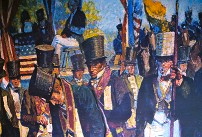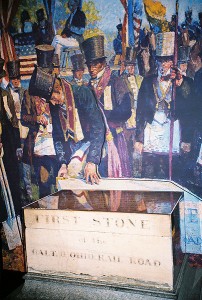Baltimore and Ohio Railroad

Early Locomotives
The B&O Railroad Museum is a museum exhibiting historic railroad equipment in Baltimore, Maryland, originally named the Baltimore & Ohio Transportation Museum when it opened on July 4, 1953. It has been called one of the most significant collections of railroad treasures in the world and has the largest collection of 19th-century locomotives in the U.S. The museum is located in the Baltimore and Ohio Railroad’s old Mount Clare Station and adjacent roundhouse, part of the B&O’s sprawling Mount Clare Shops site begun in 1829, the oldest railroad manufacturing complex in the United States. Mount Clare is considered to be a birthplace of American railroading, as the site of the first regular railroad passenger service in the U. S., beginning on May 22, 1830. Railroads (as they are known in the US) were built on a far larger scale than those in Continental Europe, both in terms of the distances covered and also in the loading gauge adopted, which allowed for heavier locomotives and double-deck trains. The railroad era in the United States began in 1830 when Peter Cooper’s locomotive, Tom Thumb, first steamed along 13 miles (21 km) of Baltimore and Ohio railroad track. In 1833, the nation’s second railroad ran 136 miles (219 km) from Charleston to Hamburg in South Carolina. Not until the 1850s, though, did railroads offer long distance service at reasonable rates. A journey from Philadelphia to Charleston involved eight different gauges, which meant that passengers and freight had to change trains seven times. Only at places like Bowling Green, Kentucky, the railroads were connected to one another. The Baltimore and Ohio Railroad that opened in 1830 was the first to evolve from a single line to a network in the United States. By 1831, a steam railway connected Albany and Schenectady, New York, a distance of 16 miles, which was covered in 40 minutes. The years between 1850 and 1890 saw phenomenal growth in the US railroad system, which at its peak constituted one third of the world’s total mileage. Although the American Civil War placed a temporary halt to major new developments, the conflict did demonstrate the enormous strategic importance of railways at times of war. After the war, major developments include the first elevated railway built in New York in 1867 as well as the symbolically important first transcontinental railroad completed in 1869.
 Cornerstone of the B&O laid July 4, 1828 by Charles Carroll of Carrollton, Maryland, now displayed at the B&O Railroad Museum
Cornerstone of the B&O laid July 4, 1828 by Charles Carroll of Carrollton, Maryland, now displayed at the B&O Railroad Museum
The Baltimore and Ohio Railroad (reporting mark BO) was the first common carrierand Class I railroad in the U.S. as well as one of the oldest. During its peak years, the railroad extended as far east as Staten Island New York and as far west asIllinois. Most surviving trackage is operated by CSX Transportation; trackage on Staten Island is operated by the Staten Island Railway as a branch of the New York City Transit Authority.
History – 19th Century
The Baltimore & Ohio Railroad (B&O) was not the first railroad in the U.S., but it was the first common carrier railroad and the first to offer scheduled freight and passenger service to the public. The most important U.S. seaports in the early 1800s were Boston, New York City, Philadelphia, Baltimore, and Charleston, South Carolina. Baltimore had an advantage in being farther inland than the others (and therefore closer to many markets), being located almost at the head of navigation onChesapeake Bay, the estuary of the Susquehanna River. New York gained an advantage in 1825 with the opening of the Erie Canal, permitting navigation as far as Lake Erie, and in 1826 the commonwealth of Pennsylvania chartered a system of canals to link Philadelphia with Pittsburgh. Baltimore responded to the competition of the other cities by chartering the B&O Railroad on February 28, 1827. The B&O was to build a railroad from Baltimore to a suitable point on the Ohio River.
 Cornerstone of the B&O laid July 4, 1828 by Charles Carroll of Carrollton, Maryland, now displayed at the B&O Railroad Museum
Cornerstone of the B&O laid July 4, 1828 by Charles Carroll of Carrollton, Maryland, now displayed at the B&O Railroad Museum
Ground was broken for the railroad with great celebration on July 4, 1828. The first stone was laid by 90-year-old Charles Carroll of Carrollton. Maryland, the last surviving signer of the Declaration of Independence. A route was laid out to follow the Patapsco and Monocacy rivers to thePotomac, and work began. The line was opened for scheduled service to Ellicott’s Mills (renamed Ellicott City) on May 24, 1830. On December 1, 1831, the road was opened toFrederick, 60 miles (97 km). The B&O opened a branch from Relay, Maryland (then called Washington Junction) to Washington in August 1835, crossing the Patapsco River on the Thomas Viaduct, one of the B&O’s signature structures. Two years later a bridge was completed across the Potomac to Harpers Ferry, West Virginia (then part of Virginia; the separation of the western portion of Virginia did not occur until 1863). At Harpers Ferry the B&O connected with the Winchester & Potomac Railroad, thus forming the first junction of two railroad companies in the U.S. The line continued west through Cumberland, Maryland to Grafton, West Virginia, where it turned northwest to reach the goal of its charter at Wheeling, West Virginia, 379 miles (610 km) from Baltimore, on January 1, 1853, almost 25 years after commencing construction. Another line was pushed west from Grafton to reach the Ohio River at Parkersburg, West Virginia in 1856.
The B&O was considered collateral damage during the American Civil War. Incompetent Union forces and leaders often failed to properly secure the region, despite the vital importance of the rail company to the Union cause.
“There is no interest suffering here except the Baltimore & Ohio Railroad and I will not divide my forces to protect it.”
— General Philip Sheridan
This poor military strategy allowed Confederate commanders to contribute significantly to the length of the war, by conducting free-ranging military operations against the region and railroad. The B&O and its president John W. Garrett are particularly remembered for their part in the Battle of Monocacy. Agents of the railroad began reporting Confederate troop movements eleven days prior to the battle, and Garrett had their intelligence passed to authorities in the War Department and to Major General Lew Wallace, who commanded the department that would be responsible for defense of the area. As preparations for the battle progressed, the B&O provided transport for federal troops and munitions, and on two occasions Garrett was contacted directly by President Abraham Lincoln for further information. Though Union forces lost this battle, the delay allowed Ulysses S. Grant to successfully repel the Confederate attack on Washington at the Battle of Fort Stevens two days later. After the battle, Lincoln paid tribute to Garrett, saying “The right arm of the Federal Government in the aid he rendered the authorities in preventing the Confederates from seizing Washington and securing its retention as the Capital of the Loyal States.” The following prominent raids involving the B&O took place:
- Great Train Raid of 1861: May 22 – June 23, 1861
- Romney Expedition: January 1–24, 1862
- Operations during the Maryland Campaign: September 8, 1862
- Jones-Imboden Raid: April 24 – May 22, 1863
- Catoctin Station Raid: June 17, 1863
- First Calico Raid: June 19, 1863
- B&O Raid on Duffield Station: January 1864
- McNeill Raid: May 5, 1864
- Second Calico Raid: July 3, 1864
- Battle of Monocacy: July 9, 1864
- Gilmor’s Raid: July 11, 1864
- Greenback Raid, by Mosby’s Rangers: October 14, 1864
- B&O Raid on Duffield Station II: January 1865
- Gilmor’s B&O Raid: February,1865
- B&O Derailment Raid: March, 1865

